#row of chive seeds in
Text


Front corner all cleaned up and the herbs in around the figs
10 notes
·
View notes
Text
i realized just never posted my garden oops

please observe it in its half full glory!
don’t ask me why i planted alumroot that prefers partial shade in my afternoon sun receiving back garden ㅠ.ㅠ i wasn’t thinking practically i was just like WOW THEY HAVE SO MUCH ALUMROOT HERE and loved how curly and light these are. they’re called Dolce “Apple Twist” and the picture on the label shows they might get a little red in the centers :0 ALSO when i got these at lowes they let me pick out a free mum at checkout so now i have orange mums and no pot for them…. :D

here’s a closer image of my crazy flower corner. sorry for the patio umbrella shadow, the sun was sunning. also, don’t ask about the placement of these guys. idk what i was going for and why everything is so close, but i don’t really care i just want it fluffy and bug friendly >:3
we’ve got some multicolored asters in a row towards the front. there are little clumps of mixed wildflower seedlings trying their best but not getting very big. one bachelors button has shot up right next to the bush of catnip, u can see its tiny bud amongst the catnip if u zoom :P there’s a random baby catnip next to the bush. then, we’ve got some butterfly weed, and even more random wildflower mix babies.
in the empty space in front of the crazy flowers i have planted some SPINCH seeds!!! bloomsdale long standing spinchers to be exact.

lastly, THE HERB SPIRALLLlllwjwja!!!!!!!!!! i’ve been wanting to build one for soooooyyyyy long and i finally did it!!!!! there are dill and cilantro seeds on the lower side of the spiral. i’ve got oregano, chives, rosemary, and thyme seeds in my 4x4 seed tray. those are gonna go in the spiral obvs. i’ve also got some genovese basil in a planter i’m considering plopping into the spiral but am not sure yet…
BRO I ALMOST FORGOT. i put some peppermint seeds in a pot and two types of lavender seeds (munstead & something?...) in little nursery pots since my previous lavender seedling attempts mmmDIED </3.
also the saucer/dish with rocks is supposed to be a butterfly puddler but i’m not satisfied with it yet…suggestions welcome if you made it this far, also thank youuu byeeeee :3
not proofreading sorry i type kinda sporadically
#gardening#gardenblr#plantblr#catnip#aster#butterfly weed#herb garden#herb spiral#my garden#wildflowers
16 notes
·
View notes
Text
Today!! Progress in motion, it feels good. Almost sowed the cabbage but there's roots there I gotta figure out before planting.
Germinated:
- 7 cauliflower seeds !!! They should pop out the green tomorrow
- a few nasturtium seeds, hallelujah!!!
Preparation:
- Hoed and raked the beds again, then Added soil mix to strawberries, Brussel sprouts, and root vegetables beds.
- Added the rest of the mix to two raised beds. Found a lot of potatoes in those beds, soil in good condition.
Sowed:
- 3 rows of onions in root vegetables bed
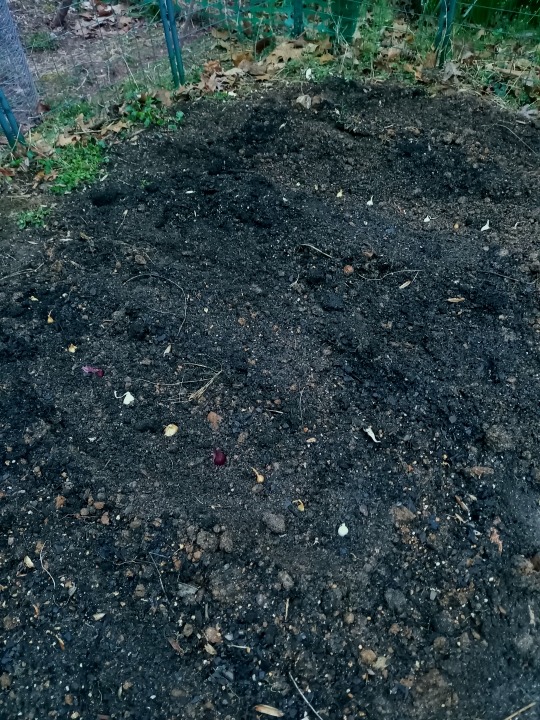
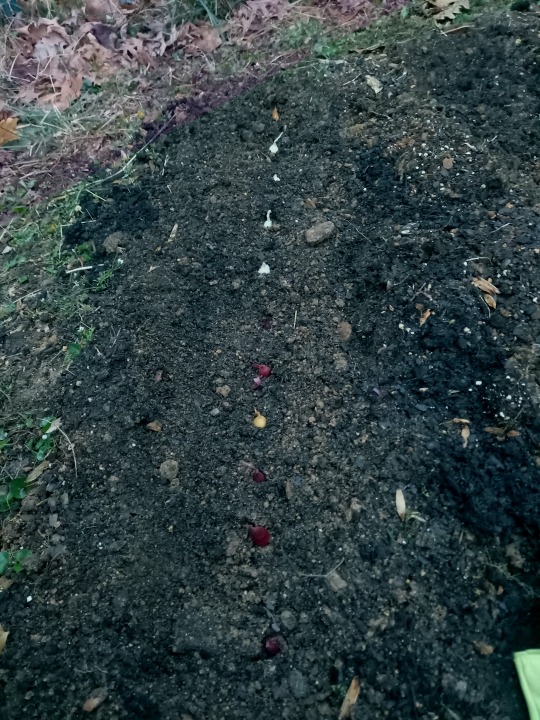
- 2 half rows of beets in root vegetables bed, 3 seeds together at a time because I watched a video today showing beets like to be very close to each other and push each other out of the ground?
- whole bed of Brussel sprouts, pretty much the whole packet ~30 seeds in
- an area of beets in shed side raised bed 3
- 1 row of sprinkled chives seeds alongside the beets and the wall of the bed. That bed is complete, I believe.
Watered everything too far for the hose with a spray bottle, painstakingly.

Lined the Brussel sprouts with rocks I found in honor of my wife's work and style in landscaping. 💘
#Gardening#Plantblr#Garden#home garden#Sowing#Soil preparation#Onions#Beets#brussel sprouts#Chives#gardenblr#garden journal#Germinated
12 notes
·
View notes
Text
11/5/23
New rule: when I buy plants, I MUST put them in the ground within 1 day. My lettuce 6-pack got chomped to bits, and lost a lot of leaves during transplant. Hell, I should have just started it from seed! The nursery is quite expensive (up to $6.50 for a 6-pack). The local college plant sale had much better prices, $4-5 for 6-packs and 4-inch plants.

But we’re planting out beds 1 and 2 more, finally. The inside corners of the arch will be for a variety of little things, including: chives, green onion (rescued from rotting in the fridge), calendula, chamomile, and cilantro. Still some empty spots that need to be filled later. The cilantro seeds are in toilet paper rolls bc something chomped through the last ones.


And I filled in the rest of bed 2! Instead of rows, I planted in circles around the olla to make different “water zones.” Zones include:
Low-growing spinach, ideally to make it easier to refill the olla
Inner circle: carrots and radish, outlined with a circle of garlic
Outer circle: alternating sections of lettuce and bok choy. More seeds were sown in the back section

I’m eager to see how this section will compare to the other side of bed 2. It’s more complicated to plant this way, but I think it will look cool and utilize the olla better. I also planted very intensely, we’ll see if they struggle.
Many more chores to do: gotta make more potting mix, pull the plants in bed 3, plant bed 4, sow cover crops, etc etc
Side note: Jesus Christ it’s been 2 weeks since I did any garden work. I also fucked up my watering schedule due to the heatwave and period and shit. It’ll all bounce back probably
2 notes
·
View notes
Text
Garden Update!

+ Well, I have another Malibu business trip coming up in a couple days, so let's see how the garden is doing; I've created a second bed and planted big and small tomatoes, as well as a few cape gooseberry (goldenberry) plants; everything's staked and tied up because it gets very windy
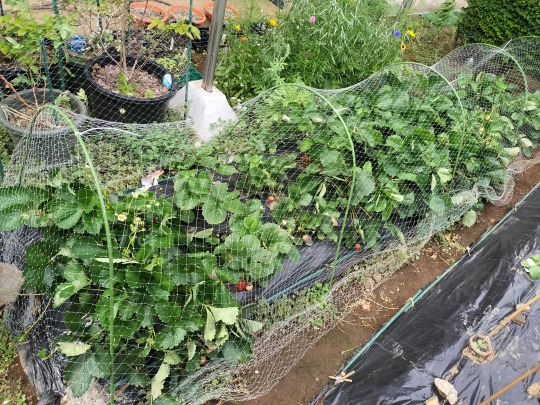
+ Strawberry row, really filled out with plants

+ Just in case you don't believe me, there's actually strawberries
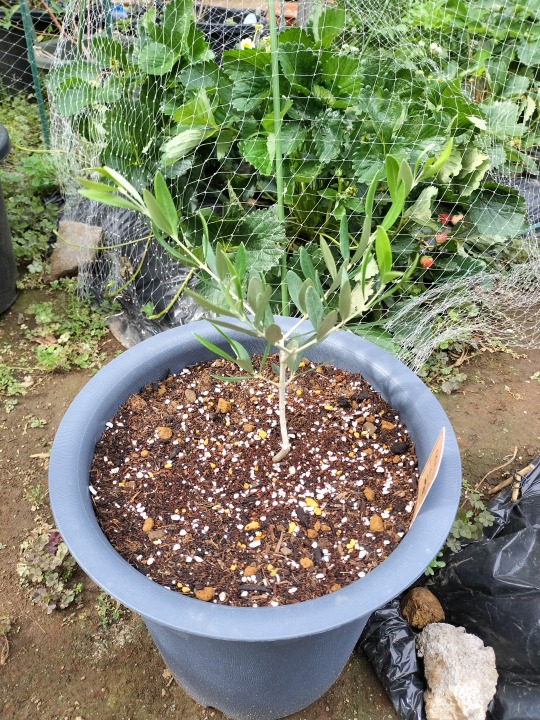
+ Here's one new addition I'm happy about; this is Oliver... an olive tree; the tree was 32 cents, the dirt was considerably more expensive; it'll be a long time before he makes olives, so stay tuned
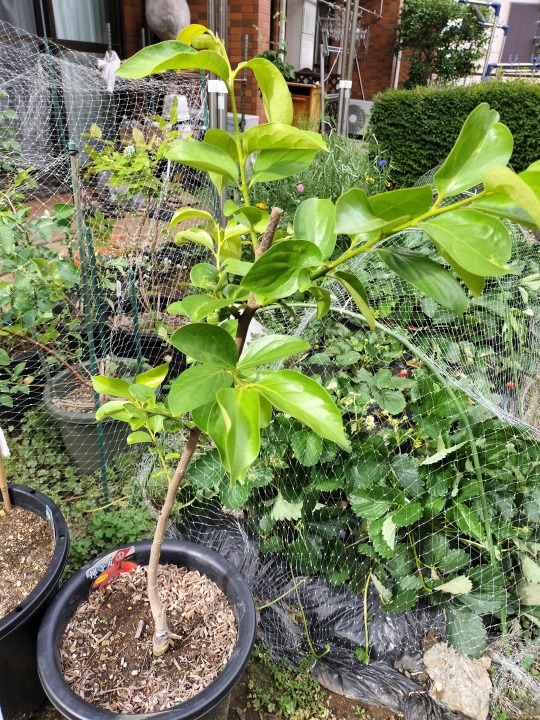
+ This is the persimmon tree; he's alive, but past the period for flowers, so nothing on him this year; considering I thought it was a dead stick just a couple months ago, I'm pleased with his recovery
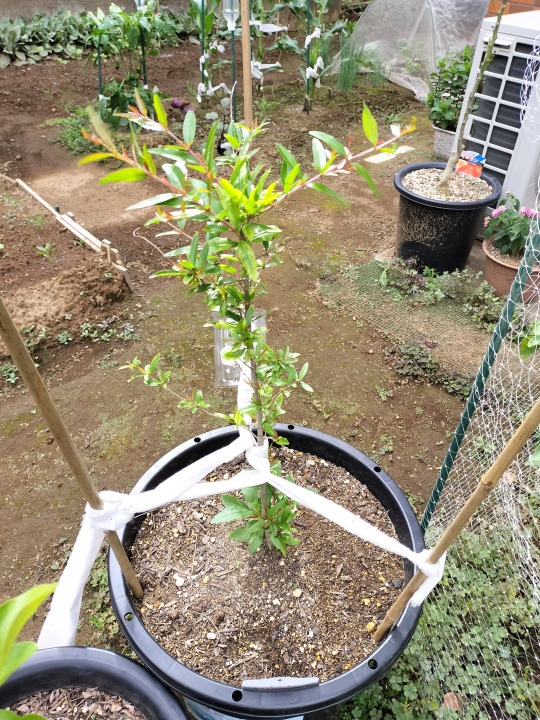
+ And the most exciting new addition: a pomegranate tree from Akina; she's all tied up due to the wind
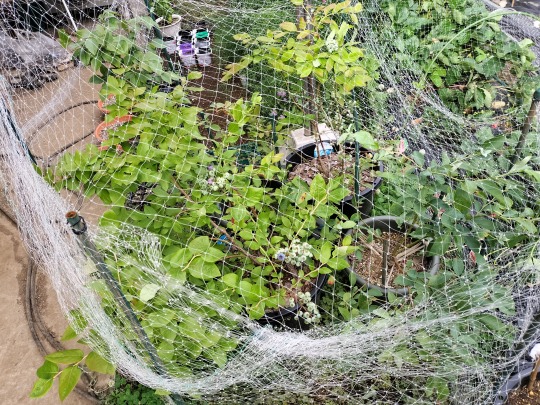
+ Blueberries... doing blueberry stuff...

+ Like making blueberries!

+ This is the bunch of flowers from a packet of seeds from my mom; here's some of the flowers:
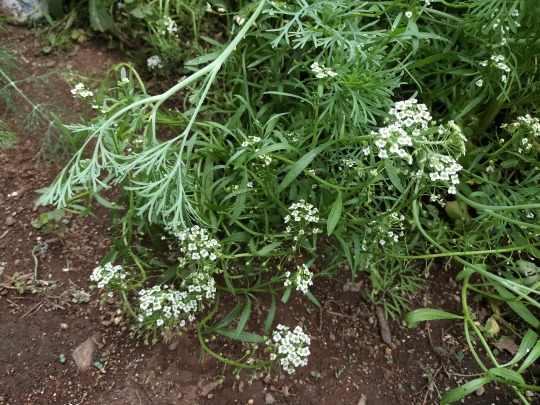
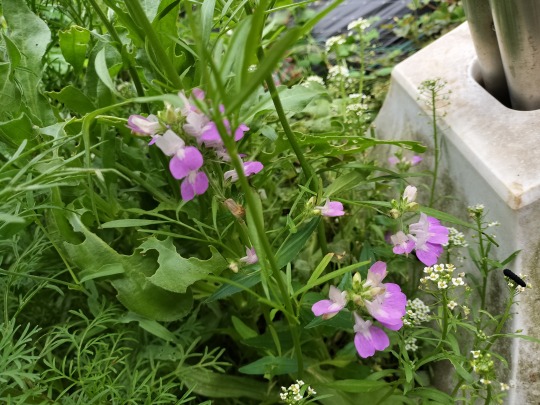
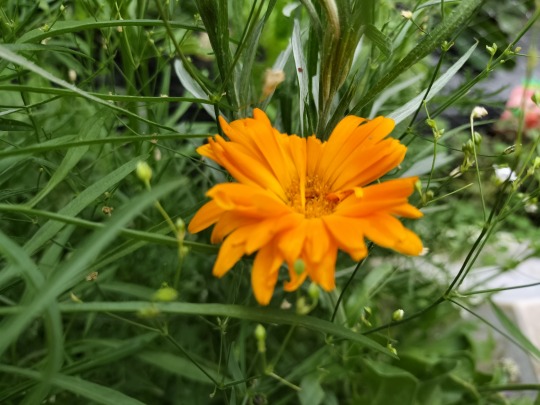

+ The bottom-right one is cornflower, which I'm excited to try and make into tea
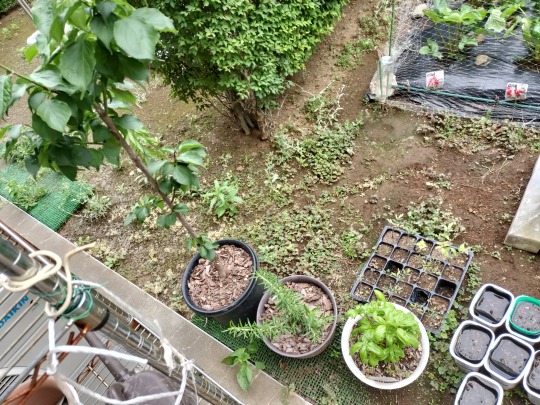
+ Some stuff on the side: plum tree (lots of blossoms, but no fruit); rosemary (doing very well); basil (doing well, tastes good); and leftover seed trays of tomatoes (as back up); the cups of water on the side is a surprise for Akina (if they grow)
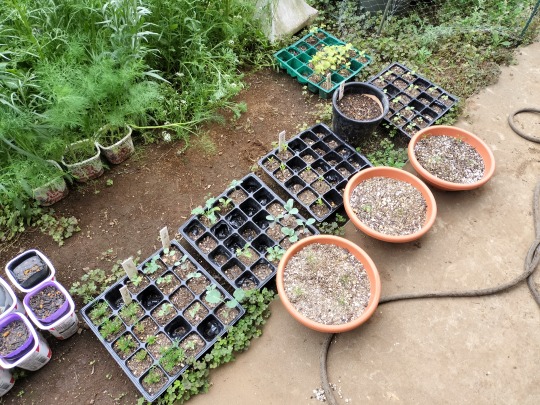
+ And more: there's dill in the yogurt containers in the top-left, but they're probably past the period where they'd taste good (I guess only young dill is good); the three brown shallow pots have okahijiki in them, which is a type of Japanese succulent you can eat
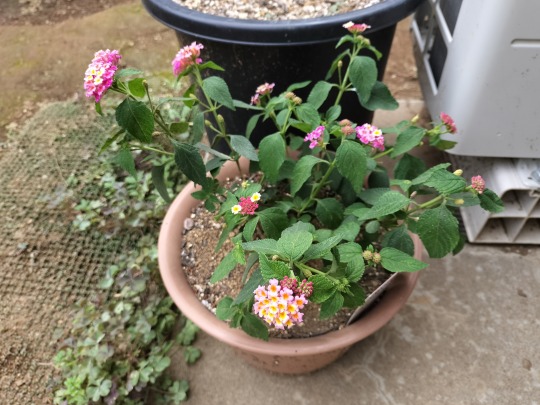
+ Lantana for Akina
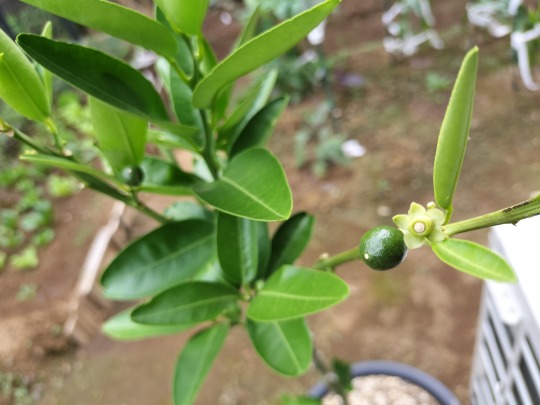
+ Iyokan (a type of Japanese citrus); there's two fruits on the tree... looking good
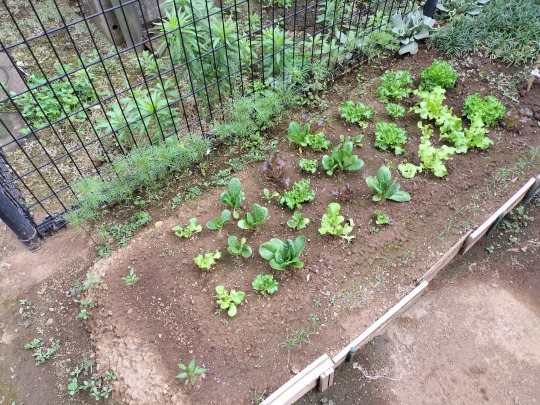
+ Practicing crop rotation by putting the lettuce over here; I reduced the amount of Romaine lettuce this time around

+ Another new addition, this is goya; I think it's called "bitter melon" in America, but it's a lot more common here; Akina doesn't like it; I kinda like it (it's super bitter)... like, really bitter; the whole plant smells like it; his name is "go-tyan"

+ Some re-arranging here... Consolidated my rock pile and freed-up all the space along the ledge for many of the smaller pots; from left to right: parsley (going strong), kiwi (male, just for the flower), tansy (smells awful, keeps away bugs), okra (looking good), and lavender (got lots of flowers for tea already)

+ Moving along... right-to-left: chives, chrysanthemum, chamomile (for tea), and lavender; and peeking into frame from the bottom-right:

+ These flowers, from a packet of seeds from my mom; they weren't supposed to bloom this season, but some of them did

+ And resuming along the ledge... starting from the chives, from left-to-right-skipping-even-numbers-unless-it's-number-four-then-reversing-the-order-of-the-rest: chives, cilantro (bolted already and probably no good), snap dragons (still going strong), some flowers that the beetles eat, and ooba/shiso
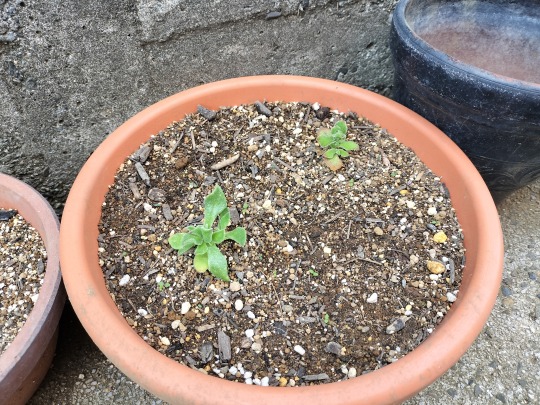
+ Last ledge entry: ice plants (for Akina)... they're actually growing much better now; I think I started them too late last year
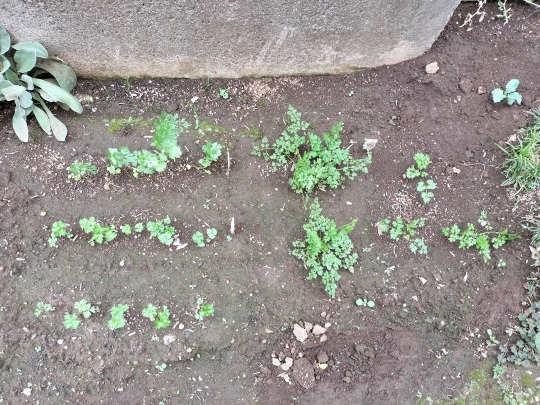
+ Previously the lettuce bed, now has herbs: cilantro (better looking) and chervil

+ Here's na-tyan, an eggplant...

+ Here's pi-tyan... small bell peppers; I think the wind really messed her up last night, gotta go check in a minute

+ Uhm... corn; if you're wondering, the plastic bottles atop the stakes are so I don't stab myself and/or poke my eye out while working; the stakes are hard to see, the bottles make them obvious; despite growing up in Ohio, I realize I know next-to-nothing about growing corn

+ Green onions; the packet said to grow them this closely without thinning... I'm trusted that's correct, but I have my doubts

+ I put a row cover up here to deter moths/butterflies from making caterpillars all over the Brassicas inside (kale and broccoli)
+ Oh no, there's a limit of 30 pictures/post
+ Well, the rest is a row of carrots, some edamame that I'm pretty sure is sick/diseased; and some snow peas from my mother that are in various states of stunted growth due to "leaf borer" infestations... but the peas they do manage to produce taste pretty good!
1 note
·
View note
Text
Cork City Libraries Sustainability Blog | Sow…Let’s Grow! Gardening in July

The garden in July and August is really the gardeners’ magnum opus. All the hard work throughout the year is finally (and literally!) coming to fruition. Just yesterday I ate my first home-grown strawberry of the year, and although a slug had technically piped me to the post, the berry was nevertheless still as sweet.
Aside from a variety of fruits and vegetables reaching maturity during these long summer days, there is plenty that can be planted now so that you can have fresh produce all year round. Here in the Hollyhill Seed Library we have several packets of carrot seeds, and if you plant them out now you will have a gorgeous crop of carrots come Autumn. Sow the seeds about 1cm deep in rows 15 – 30 cm long. Sow them as thinly as possible because you want to avoid having to pinch them out later, as this can attract carrot root fly and then all your hard work will be for nothing.
Another vegetable you can plant now for an autumn crop is the pea, which we also have in stock in the Hollyhill Seed Library. There is nothing nicer than the taste of freshly grown peas and if you grow nothing else this year, please invest the time and love into growing a couple of pea plants. Push the seed 3cm down into the soil, keep it well watered, and give it something tall to grow around – that’s all there is too it! If you plant them now you should be able to harvest the lovely little pea pods around September.
Chive seeds can also be harvested now, and I have actually managed to harvest some of my own this year and have very proudly donated them to the Seed Library. I noticed that it was growing new flowers even though the old flower heads were still on the plant so I decided something must be done. I snipped off the flowers taking a good bit of the stem with them, immediately put them upside down in an envelope and left them outside overnight so all the little insects can escape (make sure you check the weather forecast beforehand though – you do not want soggy seeds!). Most of the seeds should come out if you give the chives a good shake at this point and you can simply discard the flowers, but if you want to go the extra mile you can tie the stems together using a slip knot and keep them as dried ornamental flowers. Nothing has to go to waste!
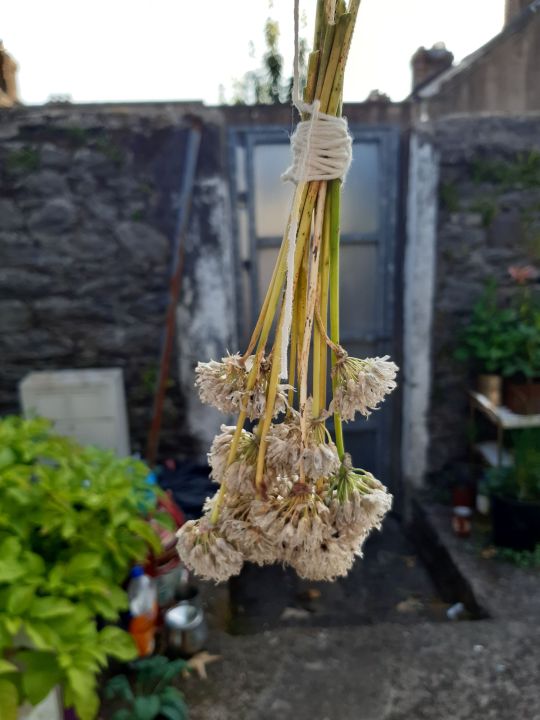
Because everything is growing so rapidly at this time of year, it is important to remember to feed your plants with fertiliser or compost – especially if you are gardening in pots. If the very thought of which fertiliser to use or how to start a compost heap is making your head whirl, you are not alone.
Thankfully we have lots of books in stock that can help you along the way, including No-Waste Composting: Small Space Recycling, Indoors and Out by Michelle Balz, The Ecological Gardener: How to Create Beauty and Biodiversity from the Soil Up by Matt Rees-Warren, and How to Make and Use Compost: The Practical Guide for Homes, Schools and Communities by Nicky Scott. I started my compost heap from scratch just under a year ago and it is coming along nicely now. The first time I used it, it was a disaster – nothing grew! I had used it far too soon and it was still so acidic that it had killed the seeds. Disheartened, I left it for several more weeks and even invested in some worms that had been destined for the end of a fishing line. Around mid-June I decided to try again and used it to plant some salad leaves and basil. Lo and behold, not only did the seeds thrive this time round, so too did some mushrooms, which I see as a huge bonus!
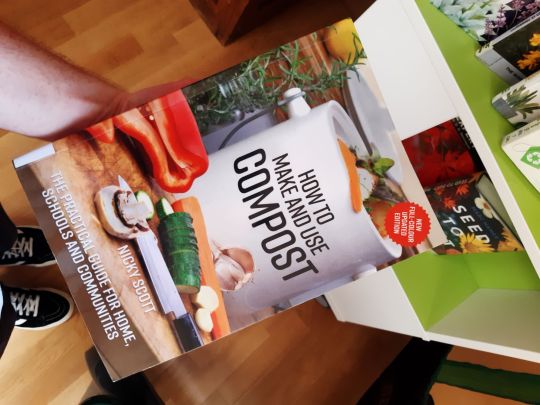
1 note
·
View note
Text
garden looks good today! didn't see any chomped leaves. things are progressing. i don't feel so well today so i didn't wake up early or do as much, but there's always tomorrow.
first, i had to release the death grip of the kabocha from the cilantro and basil and put up another trellis so it has something to climb. the edamame and icicle radish are doing well. the peppers and eggplant are too. i was able to plant some more eggplant for the opposite side and i moved over some of the cherry radish in order to make room for more bell pepper seeds. i don't know if it will shock the radish too much, but hopefully it will pull through.
i put the leeks in the onion/ garlic basket. the entire back wall will now be Korean chives and simple chives. (it should make for pretty purple and white blossoms at some point.)
pulled up all the carrots. i don't plan on doing much with the area so i will see if any of the purple haze carrots i planted a few days ago decide to grow. the area around the buttercup squash I'm going to keep clear because i see how aggressive they are in the other plot.
once the eggplant sprout, i will put them where the french breakfast Radish are... 1 row of each. (i planted 2 seeds each in 6 spots, so we will see what grows and if I'll need more room.)
i feel like after tomorrow, maybe Thursday, my efforts will be to just maintain and no longer plant. if it doesn't grow, it doesn't grow. summer is gonna be a killer and i need to start figuring out how to keep the plants from roasting in the sun.
i also need to give more attention to the tomatoes. they're doing so well that i kind of pass over them.
that leaves the radish tower and carrots i want to plant in the front, the basil and chives i need to plant up in the back when i gt the seeds, some pruning of herbs and keeping the poppies contained, and a good fertilizer.
oh, and i added some more ground cherry seeds. if this doesn't work, oh well. if it does, it's going in the empty medium pot i have waiting. i also need to peek at the corn and collard greens, and honestly, if they don't have any progress, i need to chuck them.
0 notes
Photo



BETTER LATE THAN NEVER, RIGHT? ^_^
[Picture IDs in the alt text of the images.]
Pictured above, we have a GIANT patch of chives (which I did NOT plant there, for the record. They planted themselves there from elsewhere in the yard. XD And this is after I transplanted a huge swath of them into my mother’s yard. In the same bed as the chives, and in the long bed are my five butternut squash seedlings, and in the other bed are my six eggplant seedlings.
Not pictured (because there’s nothing to see yet.):
1 bed with three rows of beet seeds planted, 1 bed with two rows of radish seeds and the back half of that bed where I scattered dill seed all around.
Should see the radishes pop up in another week to 10 days.
Still to plant: cucumber seeds, but I’m waiting for my neighbor kids for those because they have a VESTED interest in my cucumber plants every year and it’s too cute to not indulge. XD
But OMG I AM A NOODLE NOW. TT^TT
That being said, I feel MUCH better now that everything is planted. Usually I start my planting WAY EARLIER THAN THIS but I couldn’t be bronchitis. :P
But YUMMY FOOD IS ON ITS WAY!! :D :D :D
My mom and dad planted: cucumbers, 2 kinds of tomatoes, zucchini, parsley, basil, (a piece of my giant chive patch ;D), orange bell peppers, and some of my cucumber seeds. ^_^ So I’d say we’re pretty set! ;D
#eirenical grows things#gardening#raised beds#vegetables#vegetable garden#it was really nice to get my hands in some dirt again#i've missed that#^_^#eirenical.photos
42 notes
·
View notes
Text
Motsunabe (Makes 4 Servings)

We bring you this recipe from our panel, “Anime Foodies: Laid-Back Camp Season 2”.
This hotpot is one of a pair of nabes that Aoi, Chiaki, and Ena get to enjoy with the liquor store proprietors who come to their aid in Episode 6 after they failed to properly prepare for winter camping at Cape Ohmama. This motsunabe – an offal hotpot especially famous in Fukuoka, Kyushu – was the nabe offering from the father/daughter duo who rescued our main characters from the cold.
6 Cups – Dashi
4 TBSP – Soy Sauce
3 TBSP – Mirin
1 1/2 Pounds – Beef Small Intestine (Beef Large Intestine/Pork Intestines)
1/2 Block – Silken Tofu
3 Cups – Napa Cabbage (Green Cabbage)
1 Small Bunch – Garlic Chives (Green Onion Tops)
3 Cloves – Garlic
2-3 – Dried Togarashi Peppers (Fresh Togarashi Peppers/Dried Chile de Arbol)
1 TSP – Toasted Sesame Seeds
8 oz. – Fresh Ramen Noodles (2 Packs of Instant Ramen without the Seasoning Packets)
Mix your dashi, soy sauce, and mirin at home and bring this base to the campsite in one or more containers.
Remove the intestine from their package and trim any excessive chunks of fat while ensuring that a decent amount of fat remains.
Slice the intestines into 2-inch sections and rinse briefly in clean water.
Bring a pot of water to a boil, blanch the rinsed intestines for two minutes, strain, and discard the blanching liquid.
Bring your hotpot base to a boil, add the intestines, reduce the heat to low, and simmer for 10 minutes.
While the intestines simmer, roughly chop the napa cabbage; slice the tofu into large bite-sized chunks; remove the fibrous bases and tips of the garlic chives and cut into 2-inch sections; and finely slice the garlic and togarashi peppers.
When the simmering has finished, cut the heat and arrange the intestines in one section of the pot while placing the cabbage and tofu into their own sections of the pot.
Add the garlic chives in a single row across the top of the other ingredients and top with the slices garlic and togarashi peppers.
Cover the pot, bring to a boil, lower the heat, and simmer for 10 minutes.
Cut the heat, add the sesame seeds, and eat the ingredients of the hotpot.
Once nearly all the ingredients are consumed, boil the ramen in fresh water in a separate pot for half of their recommended time, drain, and add to the nabe pot.
Bring the pot to a boil, complete the remainder of the recommended cooking time, cut the heat, and either serve the noodles in bowls or consume as you would any other hotpot ingredients.

Optional/Notes:
Any kind of dashi will work for the hotpot base in the recipe. We used a konbu/katsuobushi dashi, but chicken dashi is often used in Fukuoka. Miso is also popular as part of the hotpot base; if using, replace 3 TBSP soy sauce for 2 TBSP miso.
If using large intestine, the additional simmering time of Step 5 can be significantly reduced or omitted entirely.
Cup measurements aren’t perfect for the cabbage, but the extremely varied size of napa cabbages makes it the most ideal for this recipe. Do expect to have some left over.
If using packs of instant ramen, it is not necessary to start boiling the noodles in another pot, but do make sure you have some additional hotpot base in case additional liquid is needed.
#anime#anime food#anime foodies#nos anime#camping#food#yuru camp#yurucamp#laid back camp season 2#camping food#laid back camp the movie
11 notes
·
View notes
Text
5 steps to a productive food garden this fall
While many people only grow food gardens during the spring and summer months, there’s no reason that your gardening season has to end now, unless you are in a part of the world where the weather turns bitterly cold in the fall, and you have no season extending tools (or options for indoor growing). As the hot summer months give way to cooler temperatures, you can begin planting new varieties of food crops, or continue successive planting of summer-to-fall vegetables and herbs.
In many ways fall gardening is easier, with cooler temperatures, reduced watering requirements, and hopefully fewer issues with herbivore pests in your garden. At the same time, fall planting and harvesting can present its own set of challenges, some of which are discussed below. If you’re planning to continue your food garden into the fall months, or even if you’re doing so this fall for the first time, you’ll want to ensure that you get off to a good start. Here are 5 things you can do now to make your fall food garden thrive so you can reap a productive harvest over the next few months.
Amend and mulch the soil
Fall is a great time of year to put fallen leaves to good use. While many people bag these leaves for recycling, you can also use them in your garden beds to mulch or to improve the quality of your soil. For mulch, shred or manually break down the leaves and spread evenly over the soil to retain water and protect from the heat or cold. For compost, alternate the leaves with kitchen scraps or manure to improve the quality of your garden before planting or transplanting.
Plant species that will attract bees to your garden
Cooler temperatures make it more difficult for bees to do their work and survive the winter. Plant pollen is the primary way that bees get their protein, and the nectar they get from plants (which they convert to honey) provides them with carbohydrates, where they get their energy to carry out their daily activities. To attract bees to your garden (after all, they’ll be helping your plants with pollination), plant the kinds of vegetation that will bloom during the cooler months. Flowers that will attract bees to your garden from fall and into the winter months include rosemary, primrose, heather, calendula, crocus, and cornflower.
Choose your plants wisely
Although you can plant or place your cool-weather crops inside of a greenhouse, cold frame, hot box, polytunnel, row cover, pop-up-plant protector, or heavy-duty gardening plastic in order to keep them growing through the fall and winter months, you can also grow many varieties of cold-hardy vegetables and herbs without these season-extending tools. These days, it’s easy to find cold-hardy varieties of fall-to-winter seeds or seedlings at your local nursery, through a seed catalog, and even on Etsy.com.
Some plants can tolerate temperatures as low as 32 degrees Fahrenheit, especially when you cover them with a heavy layer of mulch. They include vegetables like spinach, leeks, rhubarb, rutabaga, turnips, garlic, kohlrabi, kale, broccoli, cabbage, cauliflower, Brussels sprouts, arugula, radish, carrots, lettuce, Swiss chard, celery, and herbs like parsley, chives, oregano, sage, thyme, and mint. Lavender can also survive cold weather as long as it is heavily mulched and not overwatered.
Don’t overwater (or underwater)
With temperatures cooling down, your outdoor plants won’t need to be watered as frequently as they did during the hot summer months. This is especially true if your area receives a lot of rainfall in the autumn season. While this means your workload will be lighter, it also means that your plants will be more susceptible to overwatering. With cooler temperatures, it will be harder for your plants to recover from overwatering, especially if they are in containers.
How can you tell when your plants need watering? One simple method is to make a slit in the ground (or in the potted soil) with a trowel. If you’re watering in-ground plants, the slit should be about 12 inches, which is the depth of most root systems. You may need to create a shorter slit if you are growing a shallow-rooting plant; this root depth chart by Garden Betty can help you determine how deep your plant’s roots go. If the soil at the bottom of the slit feels dry, you need to water.
Generally, watering frequently for a short amount of time doesn’t help your plants grow healthy. Strong root systems are developed when the roots of your plants have to go deep into the soil to find water. Watering deeply and less frequently forces plant roots to do this. It also helps them survive periods of drought and prepares them for survival well into the cold months. When the temperatures in the air and soil are falling below 40 degrees Fahrenheit on a consistent basis, stop watering your plants, since the ground won’t be able to absorb water after the top few inches of soil have frozen.
Fertilize in moderation
Generally, plants need fertilizer to develop healthy stems and roots, but fertilizing too frequently can result in plants with lots of stems (or large stems) but few fruits. In summer, fertilizing every 2 to3 weeks with an organic fertilizer or compost tea is a good rule of thumb. Some growers stop fertilizing altogether at the end of summer in order to allow their flowering vegetables (meaning plants that grow vegetables from flowers) to focus on forming produce. Container plants, however, deplete their nutrients faster than in-ground plants, so will need to be fertilized longer into the growing season.
You can mix a granular fertilizer into the soil when planting or work it into the top layer of soil for plants that have already been established in their beds or containers. Although you can safely use an all-purpose fertilizer for most vegetables and herbs, each kind of plant will have its own particular nutrient needs at different stages of the growing cycle. A simple soil test (which you can purchase at a nursery, home improvement store, or online) can help you decide if your garden needs fertilizer, and what, if any, nutrients, it is lacking.
amzn_assoc_tracking_id = "greenandpro07-20"; amzn_assoc_ad_mode = "manual"; amzn_assoc_ad_type = "smart"; amzn_assoc_marketplace = "amazon"; amzn_assoc_region = "US"; amzn_assoc_design = "enhanced_links"; amzn_assoc_asins = "B01HQXF0PS"; amzn_assoc_placement = "adunit"; amzn_assoc_linkid = "d3865f40cba4f714938b0efbc469aa5e";
The end of summer doesn’t have to mean the end of your vegetable and herb growing season. These days, more people have taken up food gardening, and many among them find that growing their own food into the cool and even cold-season months is a rewarding activity. There are many vegetables and herbs that thrive in cooler weather. Taking these steps to ensure your garden grows healthy and in abundance can extend the joy of gardening for you this fall season!
You may also be interested in
5 notes
·
View notes
Text
Evening planting 4/23/21
Long tomato bed got swiss chard down the back, spring onions (blushing bunch) ~halfway down the front. Get more onion seeds!
First rightmost bed, next to the kale, is national picking cucumbers. There's still a square of room at the near end. Second rightmost bed, by the ants, is butternut squash.
Chives in little rows in the herb bed.
Middle row at the bottom is sunflowers: border mix, evening sun mix, teddy bear in the front.
The bed just to the left of the kale has, from near to far: purple coneflower, black eyed susan (very few), lilliput mix zinnia, oriental mix poppy, and early bird zinnia.
All watered in. Flowers scattered, everything else in rows, more or less. The signs are still wrong for this, but I couldn't wait 😊 They're better this weekend, though, so I'll plant some more!
I'd better draw up a map of the beds, so I don't confuse myself.
#garden2021#vegetable garden#spring planting#planting by the signs#flower gardening#vegetable gardening#flower garden#garden log
19 notes
·
View notes
Text

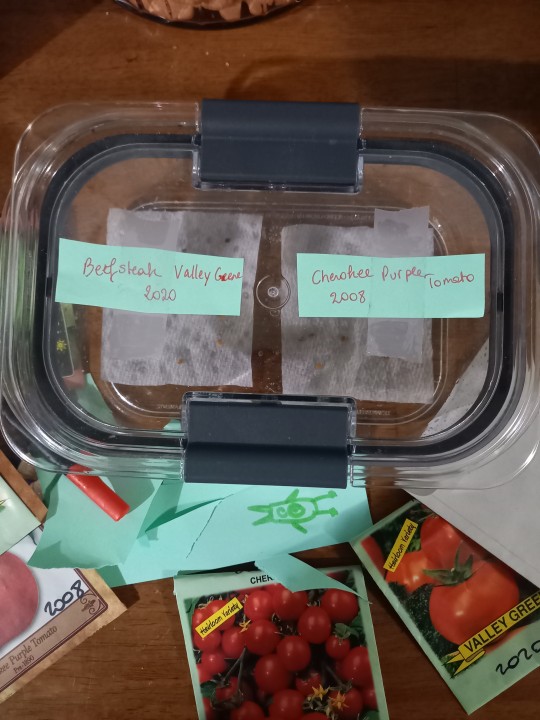
We have lots of tomatoes and tomatillos that sprouted now, and peppers are finally germinating.
We repotted the olive tree with vermiculite, sowed more broccolini in a tray indoors in case the outdoors ones don't come up, and prepared old seeds in wet paper towels to see if they're alive. Two kinds of tomatoes, one chives, and one dill.
Aragula is sprouting outside, onions are growing a bit of green, and some sprouts can be seen in the carrot rows. 🙏
6 notes
·
View notes
Note
What do you do for hobbies, apart from gardening? What have you been growing in the garden? Do you have any favourite plants?
Hobbies?
It's a little strange to think of things as hobbies - given the life I've led, but I suppose they are, huh?
Motorcycles - I like riding, but I enjoy a bit of grease-monkeying too. I like to work on them. I have a project I'm working on now - something I found at an auction that needs some repair work. Not sure what I'll do with it when I get it finished, but it gives me something to do.
Reading - I have a lot to catch up on. Sometimes it's news articles on microphish, but when I feel like just enjoying a read - not going to lie, sci fi and high fantasy are my bag.
Building - I have an A-frame cottage I've been working on in upstate New York. Finished the majority of it last year. It's a nice, private little spot I can go to get away from ... everything. Nobody and nothing but hills, trees and meadows for miles in any direction. Literal miles. I put a lot of myself into that place - and I know every nook and cranny in intimate detail. I like smaller projects too - all the trellises and planter boxes on the roof - I did those with a little help from the neighbors.
And Gardening, obviously. It was a way to channel all my .. energy.. into something productive. To prove to myself I could keep things alive. That I could care for something. I heard plants were a good first step, so I rescued some wilty little Pothos from a broken planter in the trash. I was able to bring it back - it was one of the first residents of the rooftop garden, but before that it lived in the kitchen and out on the balcony in nice weather. It's my favorite, probably for predictable reasons.
The garden is sort of a community project. It started with just a few planters for growing some food things from grocery waste - avacado seeds and celery cut offs, that sort of thing. But the neighbors liked it and so it grew. Next thing I know, we're building a little green house up there together. We got a little seating area. We have more planters and more people are contributing. We have trellis and string lights..
I didn't plan for it but I'm glad it's going this way. It's providing income for some of the families who wouldn't otherwise have any ... they can take the stuff that we grow up there and sell it at the farmer's markets. They can trade with people in the are for other things.
We're still working out what grows and what doesn't and how to care for everything, but we have a huge variety of stuff up there. Potted herbs - the kind you'd expect. Rosemary, Mint, Thyme, Chives and so on. We have a few rows of leafy greens.. like cabbage, lettuces, kale, celery. We have a row of hanging tomato plants. We have a few deep beds or things carrots and potatoes. And I've made sure to scatter some pollinator positive things out there, too. Butterfly bushes and things bees and butterflies like.
We have some berry bushes, a strawberry patch everyone is looking forward to this year. Last July we had a really nice fireworks viewing party up there and we're going to do the same for the New Year. A little music, the lights on, barbeque stuff (yes even in the cold).
We have plans to expand - One of the ladies knows how to grow a variety of melons from a hanging sort of trellis set up? So we're going to try that and the kids are always bringing me stuff they want to try and grow. I think we're going to try some beans this year, too.
And we just finished a chicken coop and run.. I'm looking forward to bringing some chooks home when the weather warms up.
3 notes
·
View notes
Text
May 2021: The Last Friday
Spent chive blossom with seeds:












We went to Plot 420 to do a little planting.
These are the first seven rows of corn seed that we planted. The seed is Will’s Early June that we got from Victory Seeds. The spikes & twine are what we use as guides to help keep the rows straight when we are hoeing them for planting:

We also planted these marigolds as companion plants to our Black Beauty eggplants. Despite being a plant with a hardy reputation, my queen & I have had the worst luck growing marigolds... whether at Plot 420 or at the house. We’re hoping this year will be different:

#chive#chive blossom#chive seeds#garden#backyard garden#flowers#daisy#tiny bees#butterfly bush#monarda#bee balm#assassin bug#blue salvia#long-legged fly#butterfly#Jumping Spider#skipper#spirea#beetle#community garden#shelby county community garden#plot 420#gardening#planting#eggplants#marigolds#life in memphis
2 notes
·
View notes
Text
My Syracuse Pollinator Garden - Year 2
Hi everyone! I’m sure a lot of us are facing stress during these troubling times and so as I’ve mentioned before, gardening is an excellent way to take your mind off of current events, de-stress, reflect and connect yourself with nature while remaining in the safety of your own property. Last year, when I moved into my Syracuse apartment (technically a room in my landlady’s house; I’m here for grad school), I was granted permission to start a pollinator garden. I am a pollinator ecologist slash conservation biologist so I bring some expertise with me here. I say this because I always encourage anyone who sees this and is curious about doing it yourself to come and ask me questions! I highly recommend you check out last year’s post which thoroughly goes over 1) the principles of gardening for pollinators and wildlife, 2) resources to help you learn more and get started, 3) what plants I have in this garden, and 4) how it progressed over the course of the summer in 2019. Unfortunately, because of fieldwork and coursework I had trouble keeping up with it regularly so I think I missed a fall installment. I intend to be more thorough this year. Quite a lot has already happened, and I will review it the best I can and from this point forward, attempt monthly updates.
I also want to mention that I’ve learned a lot since last year too - better ways of doing things, since I’m not a landscaper. Such as, you don’t have to break your back digging up turfgrass for hours on end. Instead, you can smother it for three months with old newspapers and get rid of it that way. It’s also important to note that the way I have my garden laid out is not ideal for a pollinator garden, it doesn’t follow every recommended principle. That’s because I had limitations and conditions under which I had to work, given that it’s not my own land and I had limited funds. But any effort is better than nothing, so don’t think that just because it’s not perfect, it’s not worth it. It is! You can always build, change, or improve upon it later.
In the second year of a new garden with perennials, you can expect a lot more vibrant growth - the plants have established root systems and can put more energy into above-ground growth and flower production. Thus, I was thrilled to see my plants growing more vigorously than before!
MARCH
Here in central New York, March was still freezing, wet, and snowy. But, by the end of the month, the garden was starting to show signs of life, sending up the first shoots of hardy native perennials.
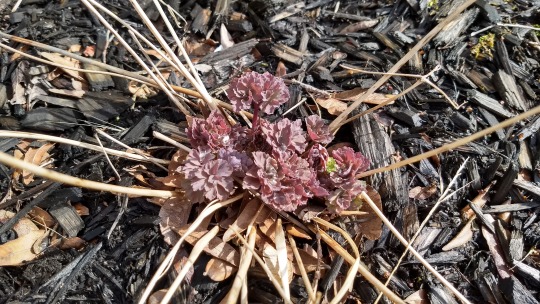
In particular, the Jacob’s ladder already had quite a lot of new growth, with the nodding onion and yarrow close behind. In my herb garden, the chives had erupted with force from the leaf litter. The yard was still messy, with dead stems and fallen leaves blanketing much of the ground. My landlady insists I clean these, but if it’s your choice, leave the leaf litter around where you can. It’s important habitat for invertebrates and returns nutrients to the soil as it decomposes.
APRIL
The world was beginning to wake up. I had cold-stratified hundreds of seeds of native plants I’d collected last fall, and it was time to take them out of the fridge. The wild cucumber (Echinocystis lobata) had already sprouted, so I planted them in pots. The rest, I put in a seed starter tray.

Next, within the first few days of April, male hornfaced bees (Osmia cornifrons) started emerging in multitudes from my bee hotel. These are a non-native, but naturalized, species of mason bee common in suburbia and they are the most frequent users of bee hotels in the northeast. I watched as they dug through the mud cap on their natal nests, peeking out with fresh eyes at the sun for the very first time. I felt like a proud parent. (You can see more pictures here)

At the same time, male Dunning’s mining bees (Andrena dunningi) were patrolling the new nest sites of females, dug in the soil between the stones laid down near the front door.
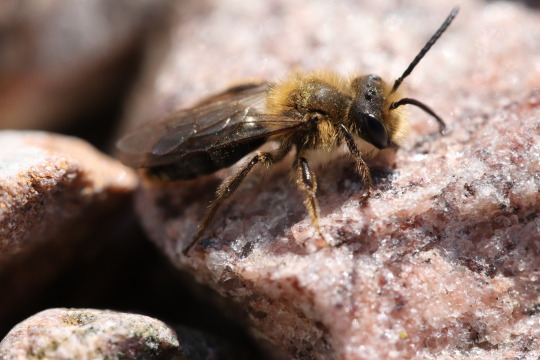
There wasn’t much for these bees to forage on yet, mainly the wild violets that grow each year on the lawn and my landlady’s invasive vinca. But many more of my perennials had started to come up, and I decided it was time to cut the dead stems.

It is best to cut dead stems back in April or so if you’re in a northern clime; the purpose of this is to offer nesting places for stem-nesting bees, which will start flying in April and May. Don’t cut them to the ground, give them several inches. Leaving stems through the winter also allows birds to forage on the seedheads.
Towards the end of April, despite several more snowstorms, the barren strawberry began to bloom.

I also saw the emergence of the female hornfaced bees, with males pursuing close behind. It is advised that you discard a bee hotel after the bees have emerged, or else they will try to nest in it again, which can lead to high mortality rates, as an old structure harbors parasites and is generally dirty.
MAY
May was a month of excitement. Given that I have been at home almost every day instead of being on campus, I was able to closely monitor the progress of the garden, apart from a week spent at home for my birthday. The dandelions dotted the yard, attracting gynes of common eastern bumblebees (Bombus impatiens) and the first honeybees (not native, need I remind you).

Alongside the dandelions was ground-ivy, which sent up stalks of purple flowers also used by the bumblebees. Almost all my plants had sprouted at this point.

My wild cucumber, which is a vine, had grown so rapidly that I couldn’t give it support fast enough, and eventually it decided to wind itself around my drapes. I brought one home as a gift for the parents, and placed the other two outside and snaked them around the front banister. However, despite my best efforts, only two other seeds from the hundreds I cold-stratified sprouted. A disappointment for sure; I was hoping to have swamp milkweed in the yard. But, there’s a chance for the wild hibiscus! Alas, with new growth comes deer, traipsing through the yard each night intent on nibbling my natives. They hit the columbine heavy this year as they did last year, and that stunted its growth and prevented it from flowering on time. I managed to protect it by putting a recycling bin over it each night. From the 7th to the 17th, I went home and visited a local native nursery.

There, I picked up a new plant for the garden - scarlet bee balm, Monarda didyma. I already have bee balm (M. fistulosa), but this species blooms red and is attractive to hummingbirds.
When I got back to Syracuse, I was astounded to find how quickly everything had shot up.
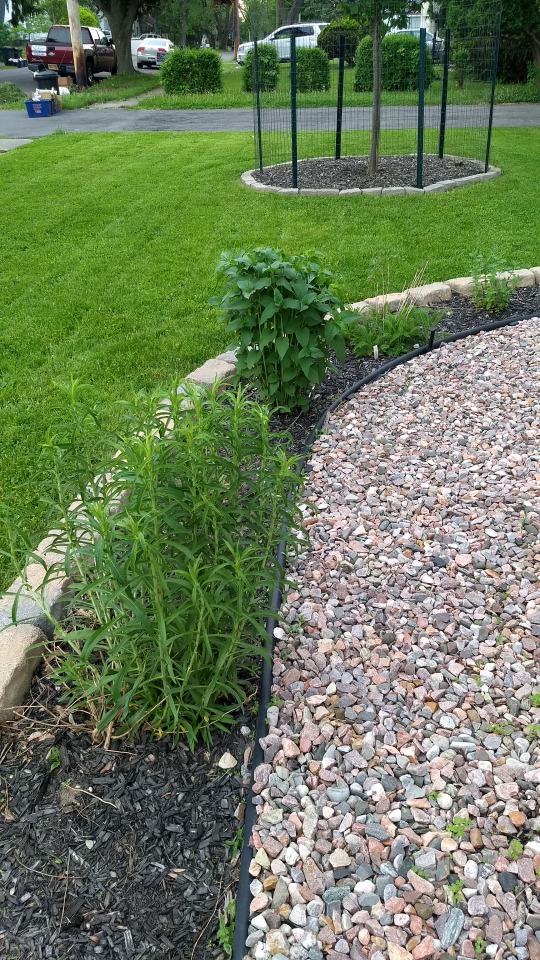
Among new blooms were the Jacob’s Ladder, woodland stonecrop, and finally, the wild columbine. The chives and thyme began to flower as well.


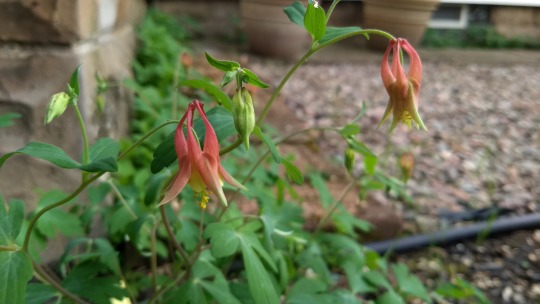
The milkweeds were one of the last to come up, being late to break dormancy. But once they did, they grew like lightning, gaining a foot in a week.

I planted my row of annuals (cosmos and sunflowers) along the walkway, and added beans to my herb garden. The dill and basil sprouted and once they get a bit bigger I’ll transplant them outside.
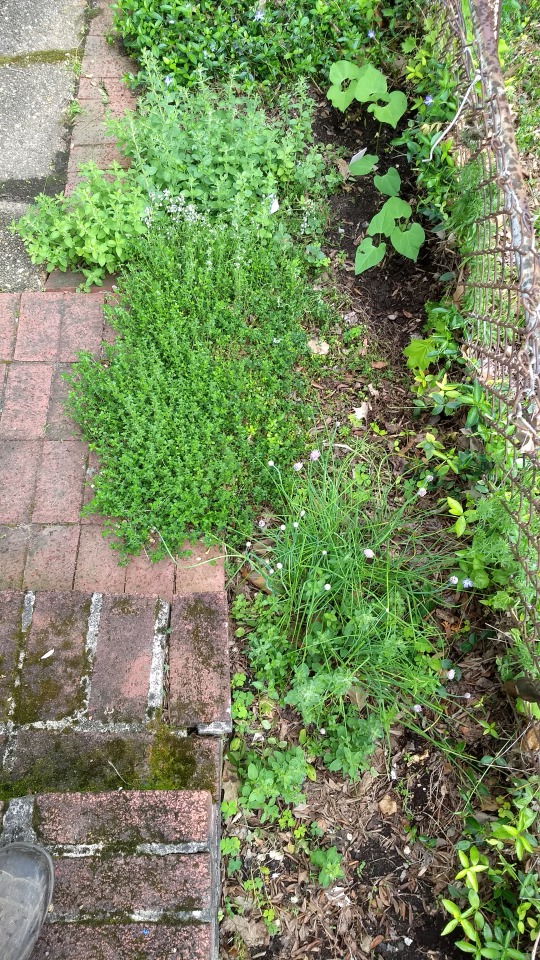
Then, in late May, I visited my advisor’s farm, and he gave me two new plants for the garden, from his own land - Golden Alexanders (Zizia aurea), which is a lovely yellow-flowered member of the carrot family which blooms in spring, and the classic purple coneflower (Echinacea purpurea). They transplanted well.

Honestly, everything is doing better than I could have hoped. What were ungainly spaces between the plants last year are starting to fill in as they grow more vigorously - the single-stalked milkweed I put in last May is now 17 stalks, and I see seedlings of the biennial brown-eyed susans coming up all around it in a three foot radius. Even the purple prairie clover which was eaten to the ground by rabbits last summer has miraculously returned. The only thing I am still waiting on is the bottlebrush grass, which remains dormant. It’s a warm-season grass, so I hope as we get sustained high temperatures in June, it will come back! But its seedlings too are popping up all around the beds.
And this sums up spring! It has become cold again for the week, but that won’t halt the growth once it’s started. The New England aster is almost half as tall as me, and my black raspberry has flowered and hopefully will produce a small handful for me to enjoy!
Check back in late June for another update on the garden!
18 notes
·
View notes
Text
remember when i said i was done with the garden...

ok, but hear me out... carrots for succession planting (i need to pull them up soon ish).
pepper seeds to fill in the empty space of my shishito peppers (i will be a brat and try to move one... ugh, i know, I KNOW!).
Nasturtium will be companion planted with my winter squash.
Daikin radish because i was looking for that yesterday and got the icicle radish thinking that's what that was.
garden updates:

Little cups protect the newly planted purple basil and habanero sprouts for a while until they're established. I'm still losing 2 of the habanero plants, i think the seedlings were too little, but i have 8 more to work in, so I'll wait until the seedlings have maybe 4 to 6 leaves.

The carrots and bolted Chinese cabbage. here is where I'll replant the purple carrots and put in the winter squash.

The empty space near the wall is were i planted chives. that hole is were my dad tried to plant more collard greens, but i think the seeds are bad. i did three rows of French breakfast Radish were the bok choi used to be and i'm going to plant a few nasturtium instead as a companion plant to the squash and long beans.
Next side:

Mixed spring greens, a shitton of tomatoes (I'm consistently thining them out. i forgot to snip the flowers so i might have a few tiny tomatoes soon.)

the empty hole were the new peppers will go.

A few nasturtium between the kabocha and eggplant. There are more poppies planted against the wall.

i interplanted the icicle radish in between the edamame and planted some dill in the corner beside the ac.

odds and ends. Dates, the winter squash that will go in place of the Chinese cabbage, extra habanero seedlings, strawberry, herbs, 3 little unknowns, and the ground cherries and grapes in the toddler trays that refuse to grow.
oh, and the seed pods from the marigolds I've been pinching off. 😂
0 notes